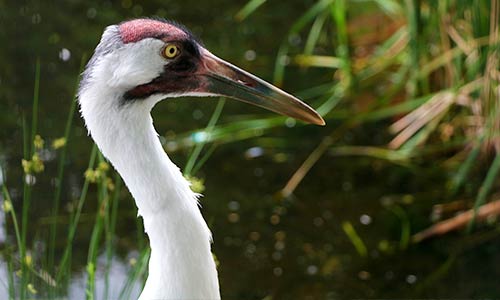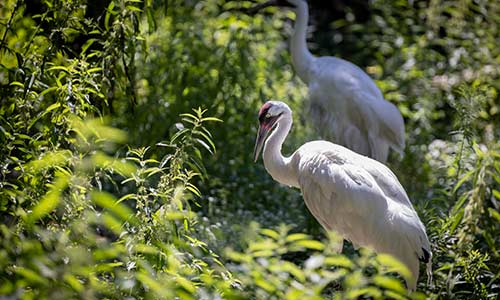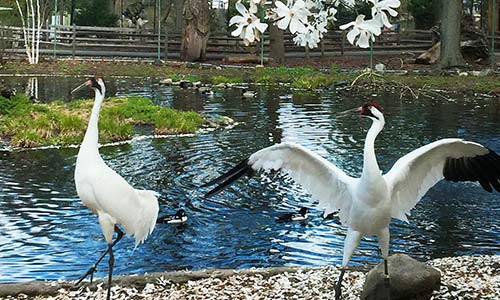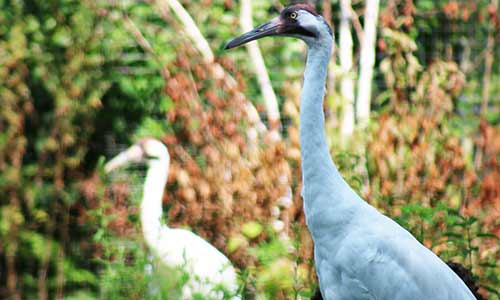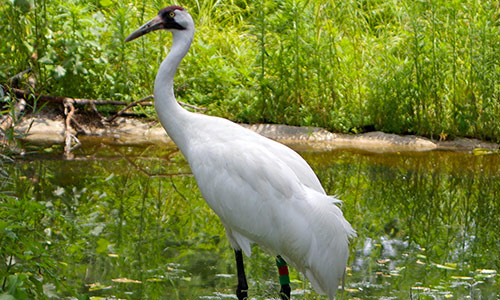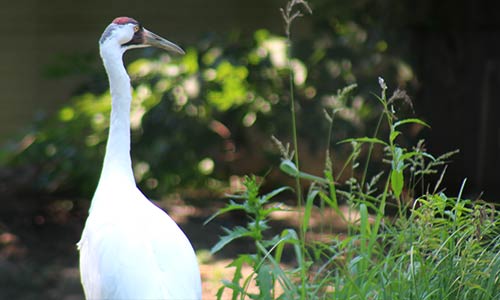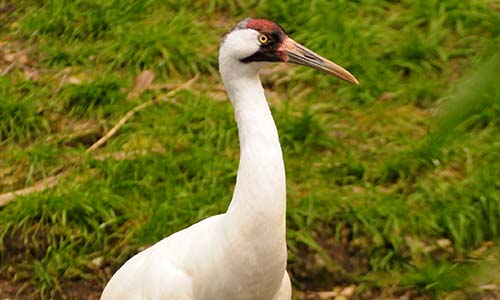Whooping Crane
Grus americana
About the Whooping Crane

Class: Aves
Order: Gruiformes
Family: Gruidae
Genus: Grus
Species: americana
Whooping cranes are noted for their stark white feathers and black primary (flight) feathers, which are only visible during flight or courtship dancing. These birds take their name from their distinctive whooping call, which can carry over several kilometers as a way to advertise their breeding territory to other whooping cranes.
Migrating whooping cranes fly like a glider, on fixed wings. They spiral up using updrafts, glide down, and begin spiraling upward again. This method of flying is energy-efficient and enables cranes to fly nonstop for great distances.
Committed to Conservation
Whooping cranes are one of only two crane species found in North America. After declining to only about 22 wild birds in the 1940s, there are about 800 whooping cranes left in the world today. While this represents less than 4% of its historic size, the whooping crane population continues to increase by about 4% a year due to extensive conservation efforts on their behalf.
We're proud to support the Association of Zoos and Aquariums' SAFE initiative: A commitment to harness our collective resources, focus on specific endangered species (including whooping cranes), and save them from extinction by restoring healthy populations in the wild.
AZA members are taking part in conservation breeding and reintroduction programs to bolster the numbers of whooping cranes in the wild. Members are also working to identify critical habitats and provide funding for field conservation projects that address wetland habitat quality, illegal shootings, and minimize deaths or injuries from collision with power lines during migration season.
Whooping Crane Facts
Appearance:
Whooping cranes are the tallest of the North American bird species. These long-legged birds are noted for their stark white feathers and black primary (flight) feathers, which are only visible during flight or courtship dancing. They have a small black patch of feathers below their crimson crown. They have yellow eyes and a long, olive-colored pointed bill that’s pink at the base. Young cranes are cinnamon brown in color with a dull gray or brown underbelly, whereas adults are white. Their primary wing feathers and legs are black, and their toes are grayish-pink. The crane’s crown, lores, and malar areas are bare skin that varies in color from bright red to bristled black.
Size:
- Adult male, 16 pounds; Adult female, 14 pounds
- Both males and females are about 5 feet tall with a 7- to 8-foot wingspan
Diet:
These omnivores will eat a variety of plant and animal material both on the ground and in the water. Their primary wintering foods are blue crabs and wolfberry fruits. They’ll also eat clams, mice, voles, acorns and snakes.
Reproduction:
These birds live primarily in breeding pairs or small family groupings. They form extremely strong pair bonds. Breeding season lasts from late April to May. Eggs are incubated for up to 35 days. The average number of offspring is two, with an equal sex ratio of males and females. Cranes reach sexual maturity between the ages of 4 and 5.
Behavior:
Whooping cranes take their name from their distinctive whooping call, which can carry over several kilometers as a way to advertise their breeding territory to other whooping cranes. They use a variety of vocalizations including stress, food-begging, alarm, guard, and nesting calls. To ward off predators, cranes use distraction and threat displays that include bowing, hopping, wing flapping and leaping. They also have elaborate courtship displays.
These birds are diurnal (active during the day) and roost on the ground at night. They exhibit head-bobbing behavior when they’re walking. During flight, they can flap, soar or glide. Generally only young chicks swim.
Migrating whooping cranes fly like a glider, on fixed wings. The birds spiral up using updrafts, glide down, and begin spiraling upward again. This method of flying is energy-efficient and enables whooping cranes to fly nonstop for great distances. In flight, these birds are distinguished from other large white birds by their long necks extended forward and their legs that trail straight behind.
Habitat/range:
Whooping cranes prefer wetlands, marshes, shallow ponds or lakes. Their nesting habitat often consists of open areas that are closer to water and vegetation and provide good visibility of predators. During migration, whooping cranes seek similar habitats in wetlands, submerged sandbars, agricultural fields, and coastal marshes.
Historically, Grus americana is a migratory species, but only two out of the three existing wild populations are migratory. These migratory populations spend the summer in northwestern Canada and central Wisconsin, and the winter along the gulf coast of Texas and the southeastern United States. Small, non-migratory populations live in central Florida and coastal Louisiana.
Median Life Expectancy:
22 - 30 years
You Can Find This Animal in the Alfred Huang North American Crane Exhibit
AZA SAFE: Saving Animals from Extinction
We're proud to support the Association of Zoos and Aquariums' SAFE initiative: A commitment to harness our collective resources, focus on specific endangered species (including whooping cranes), and save them from extinction by restoring healthy populations in the wild. More
Committed to Conservation
Zoo New England participates in the whooping crane Species Survival Plan. By sharing research and knowledge, participating institutions work together to establish guidelines that best ensure the health of captive populations, and with success, the survival of endangered species.
You might also like
At Franklin Park Zoo:
At Stone Zoo:

